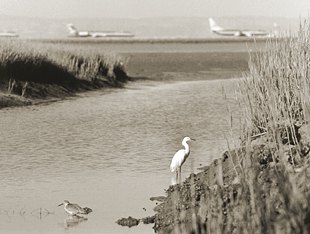
 |




by Richard Zimmerman
Published 30-Dec-2001
Proposition D, which gives San Francisco
voters the right to vote on development projects requiring 100 acres
or more of bay fill, passed in a landslide on November 6. The amendment
to San Francisco's City Charter won with over 75 percent approval
in the election, garnering more "yes" votes than any other
proposition on the San Francisco ballot.
While Prop D did not mention San Francisco International Airport's
proposed runway project, it is the only project proposed to date that
would be affected. Indeed, since the Bay Conservation and Development
Commission (BCDC) came into existence in 1965, the largest bay fill
project ever approved was 84 acres; SFIA's proposed runways would
require almost 1,000 acres.
San Francisco Mayor Willie Brown and airport management opposed the
Charter amendment initially but ostensibly switched sides after the
San Francisco Board of Supervisors voted unanimously to place the
amendment on the ballot. However, Brown and his allies were reported
to be attempting to run a bill in the State legislature that would
negate the San Francisco vote by requiring a Bay Area referendum.
San Mateo County's Voice

In October, Governor Davis signed Senator
Jackie Speier's (D-San Francisco/San Mateo) bill, SB 244, confirming
San Mateo County's right to approve the proposed runways.
Now the San Mateo County Board of Supervisors must hold a public hearing
and vote to approve any land that would be transferred to San Francisco
for the runways. The bill clarified that San Mateo County does have
jurisdiction even when the land in question is submerged, and extended
the public comment period to 120 days.
Airport Expansion Update

Reports indicate SFIA will lose as much as
$100 million this fiscal year. But despite the recent decline in air
travel, Mayor Brown and SFIA are pushing ahead with the needless runway
expansion, even while dropping other projects at the airport.
The Sierra Club's Bay Protection Campaign has called for an end to
the runway expansion project. "We call on Mayor Brown, the Airport
Commission and the Board of Supervisors to immediately suspend planning
work on Bay fill runways," said Jane Seleznow of the Bay Protection
Campaign and Chair of the San Francisco Bay Chapter. "The city
should stop wasting money on lobbyists, lawyers and consultants for
an assault on San Francisco Bay."
Since the terrible tragedy of September 11, the airlines have requested,
and received, some $15 billion in aid from the federal government.
The airlines said this money was needed to offset the losses incurred
when the FAA grounded all flights after the terrorist attack.
In fact, the airlines were in trouble before September 11.
The real problem for the airlines was the economic slow-down, coupled
with poor management practices such as overscheduling. The airline
business is driven by the economy, not the other way around as SFIA
claims.
SFIA's data shows that the number of flights at SFIA was only off
by 3.5 percent for the year as of August 31, but the number of passengers
was off by 5.2 percent for the same period. In other words, the number
of travelers was decreasing _before_ September 11.
However, the recent decline in flight operations does demonstrate
a way to solve the problems at SFIA without building runways into
the Bay. The relatively small decrease in flights led to a dramatic
reduction in delays at SFIA. "There are no weather related delays
at SFIA now," said Kandace Bender, Director of Communications
for the Airfield Development Bureau.
Department of Transportation data shows that the number of commercial
flights in September 2001 dropped by six percent over September 2000,
but the arrival delays at SFIA went to zero. That is, the number of
flights barely changed but delays disappeared. Clearly runway configuration
at SFIA is not the only major factor in delays.
The airport rejected alternatives to the runways that would reduce
the number of flights by small amounts, saying the reduction would
be insignificant. For example, high-speed trains would reduce the
number of flights by seven percent according to the Regional Airport
Planning Committee, but SFIA said that was not enough to make a difference
in delays. The current situation shows how wrong the airport is.
As Seleznow of the Sierra Club has said, "It's time to take a
step back from this irresponsible boondoggle and instead craft truly
regional transportation solutions that protect San Francisco Bay and
our quality of life." |
|
 |




Please visit ProtectOurBay.com
for updates and information on how you can help save San Francisco
Bay. |
|

